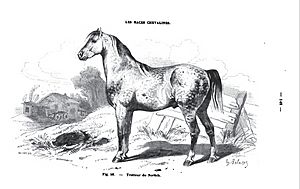Norfolk Trotter facts for kids
The Norfolk Trotter was a special type of horse breed that lived a long time ago. It came from a part of England called East Anglia, especially around Norfolk. People said it was a "large-sized trotting harness horse." This means it was big and strong, and very good at trotting (a fast, bouncy way of moving) while pulling things or carrying riders.
A Royal Beginning
In 1542, King Henry VIII made a rule. He wanted rich people to own a certain number of trotting horses. This helped the Norfolk Trotter breed become very well-known in Norfolk. Later, it got its famous name.
A very important horse in the breed's history was a stallion named Shales. He was born in 1755 and was also called "Old Shales." Shales' father was a Thoroughbred horse named Blaze. Blaze was a son of a super-fast racehorse called Flying Childers. Flying Childers was one of the first horses that helped create the Thoroughbred breed we know today.
Fast Travel and Racing
The Norfolk Trotter became the main horse for travel in England during its time. If you were in Yorkshire, the same type of horse was called the Yorkshire Trotter. Both were also known as "roadsters." This means they were perfect for traveling on roads. Sometimes, history books call them the Norfolk/Yorkshire Roadster/Trotter. No matter the name, they were all the same amazing horse!
These horses were used for riding, especially in places where there weren't good roads. They were famous for being able to carry a heavy person for long distances. They could trot at speeds up to 16 or 17 miles per hour! Trotting races were very popular in the early 1800s. The Norfolk Trotters were champions in these races.
Lasting Influence
Even though the Norfolk Trotter breed is now extinct, its legacy lives on. A Norfolk Trotter stallion named Bellfounder was brought to America in 1822. He became a very important horse in creating the Standardbred breed. This is because Bellfounder was the grandfather of a famous horse named Hambletonian 10. Hambletonian 10 is known as the father of the Standardbred breed.
The Norfolk Trotter also had a big impact on today's modern Hackney horse. So, even though you can't see a Norfolk Trotter today, parts of its strength and speed are still found in other horse breeds around the world!


